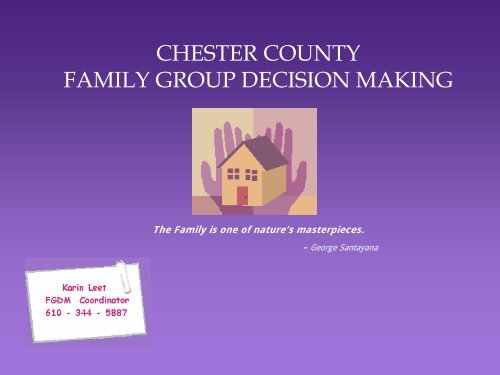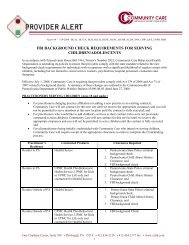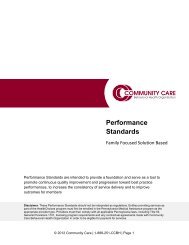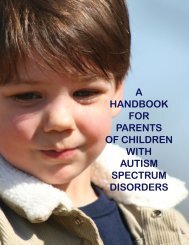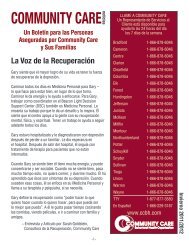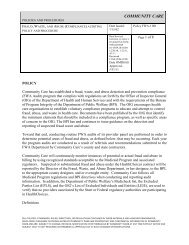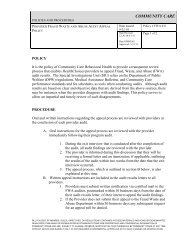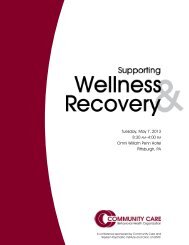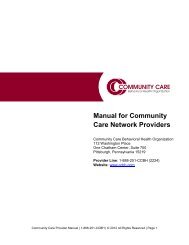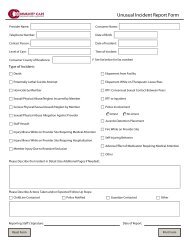CHESTER COUNTY FAMILY GROUP DECISION MAKING
CHESTER COUNTY FAMILY GROUP DECISION MAKING
CHESTER COUNTY FAMILY GROUP DECISION MAKING
Create successful ePaper yourself
Turn your PDF publications into a flip-book with our unique Google optimized e-Paper software.
<strong>CHESTER</strong> <strong>COUNTY</strong><br />
<strong>FAMILY</strong> <strong>GROUP</strong> <strong>DECISION</strong> <strong>MAKING</strong><br />
The Family is one of nature’s masterpieces.<br />
- George Santayana
History of FGDM<br />
Moari Tribe –New Zealand<br />
“PUAO-TE-ATA-TU” (DAY BREAK)<br />
13 Recommendations to the department of social welfare<br />
1989 Children, Young Persons, and their Family Act<br />
Spread to Australia, Great Britain, Ireland, Canada, and USA
Unique Features of FGDM in PA<br />
Emphasis is on the strengths of the family.<br />
Strengths are the tools used to solve concerns.<br />
Communicating using the language of concerns.<br />
Addressing concerns in a different way.
Family as The Primary<br />
Decision Maker<br />
• Family has power and accountability.<br />
• Family defines who is family and decides who<br />
attends.<br />
• Family gathering not an agency meeting.<br />
• Family Private Time helps insure that the plan<br />
is coming from the family.<br />
• Site of meeting chosen by the family.
Transformational Process<br />
FGDM is not a program<br />
It requires a change in thinking and behavior, especially in<br />
agency staff.<br />
It challenges dominant practice.<br />
It requires building partnerships.<br />
It is a practice / way of thinking.<br />
FGDM is a process<br />
FGDM is an extensive process that involves vast preparation.<br />
Process begins when the referral source offers FGDM to the<br />
family:<br />
“Would you like to do things differently?”
Values and Beliefs<br />
Families have strengths and can change.<br />
Strengths resolve concerns.<br />
Strengths are discovered through listening, noticing and paying<br />
attention to people. – L. Graber and J. Nice, Family Unity Model<br />
Family Members should be the primary decision makers for their family.<br />
Empowering people is preferable to controlling them.<br />
Empowering families will lead to families controlling their lives.<br />
Family Members know their families best.<br />
Families are the experts.
Values and Beliefs<br />
Children are best raised in families.<br />
Families should be respected.<br />
Mistakes are opportunities for growth and development. – Kinpower Associates,<br />
New Zealand<br />
All families have the greatest investment in seeing their children safe and<br />
successful.<br />
All families have the ability to come together and solve family concerns.<br />
All families have some resources they can count on to help them in times of<br />
need.<br />
Families should choose which relatives, friends, and providers will attend their<br />
conference.
FGDM Roles<br />
Family Members<br />
Primary decision makers throughout the process<br />
Decide who will be invited to the conference<br />
Have the power and the accountability throughout the process<br />
Create a plan that will address the concerns<br />
Referral Source<br />
Introduce the family to FGDM<br />
Support the family<br />
Establish bottom line concerns<br />
Identify resources for the family<br />
Accept and support the family plan
FGDM Roles<br />
Coordinator<br />
Obtain a consent form to contact the persons on the invitation list<br />
Explain participants’ role in the conference<br />
Secure/expand the guest list<br />
Ensure that all persons can participate safely<br />
Explain the concept of a support person<br />
Explain the concept of a guest speaker<br />
Explain the purpose of the meeting<br />
Secure location and food for the meeting<br />
Identify the family ritual<br />
Invite all participants<br />
Plan for a safe conference<br />
Facilitate the Pre-conference meeting
FGDM Roles<br />
Co-facilitator<br />
Scribe<br />
Helps monitor group dynamics<br />
Seeks clarification of strength and concerns<br />
Service Providers<br />
Share information relevant to the purpose<br />
Provides resources to the family<br />
Support Person<br />
Provides emotional support to<br />
a family member<br />
Ensures that the family<br />
member’s voice is heard<br />
Speaks for a family member if<br />
needed
Guidelines for FGDM<br />
Focus on the Purpose Be Respectful of each other<br />
Honesty without blaming or shaming<br />
One person speaks at a time<br />
Its ok to disagree<br />
Confidentiality<br />
What is said here, stays here<br />
Mandated Reporting<br />
Additional family guidelines
The Four Stages of FGDM<br />
1. Referral<br />
2. Preparation<br />
Family Contact<br />
Pre-Conference<br />
Referring Worker<br />
3. Family Group Conference<br />
4. Follow Up
The FGDM Conference<br />
Introductions:<br />
Participants introduce themselves and identify<br />
how they are connected to the family<br />
Information Sharing:<br />
Review guidelines and purpose of FGC<br />
Participants discuss the family’s strengths and joys<br />
Discuss concerns related to the purpose statement<br />
Share community resource information
The FGDM Conference<br />
Private Family Time: Family meal<br />
Once the meal is served, service providers leave the<br />
room. The family develops their own plan to address<br />
all the concerns and safety for the children.<br />
Plan Presentation, Consideration, and Acceptance:<br />
The group comes together to hear the plan created by<br />
the family. The referral source may ask questions and<br />
help fine tune the plan. The referral source agrees to<br />
support the plan if all criteria is met, it is safe, meets<br />
the needs of the child, and is legal.
Benefits of FGDM<br />
Family is invested in the plan. The family has a say and is more<br />
likely to follow through with a plan they helped to create.<br />
Often creates more stable living arrangements by keeping<br />
children in their family unit and decreasing hostility.<br />
Creates better futures for our children by decreasing their<br />
involvement in formal systems and decreasing repeat offenses.
Benefits of FGDM<br />
Increases family ownership by having family and extended<br />
resources take over the decision making and accountability.<br />
Opportunity to strengthen families and to<br />
have families resolve concerns in a safe<br />
environment.<br />
Saves time by frontloading.<br />
Can reduce the amount of time a<br />
referral source works with a<br />
family.
CYF Benefits<br />
• Reduced time in placement<br />
• Families make their own plan<br />
• Kinship resources identified early<br />
• Use of community/natural resources<br />
• Court more likely to go along with plan<br />
that is already sanctioned by the family
JPO Benefits<br />
• Fits in with BARJ Principles<br />
• Reduced time in placement<br />
• Use of community/natural supports<br />
• Court more likely to go along with a plan<br />
that is already sanctioned by the family
MH Benefits<br />
• Fits with Wellness and Resiliency Model<br />
• Reduced time in placement<br />
• Use of community/natural resources
Contact<br />
Karin Leet<br />
FGDM Coordinator<br />
Chester County CYF<br />
(610) 344-5800 Office<br />
(610) 883-1203 Cell


